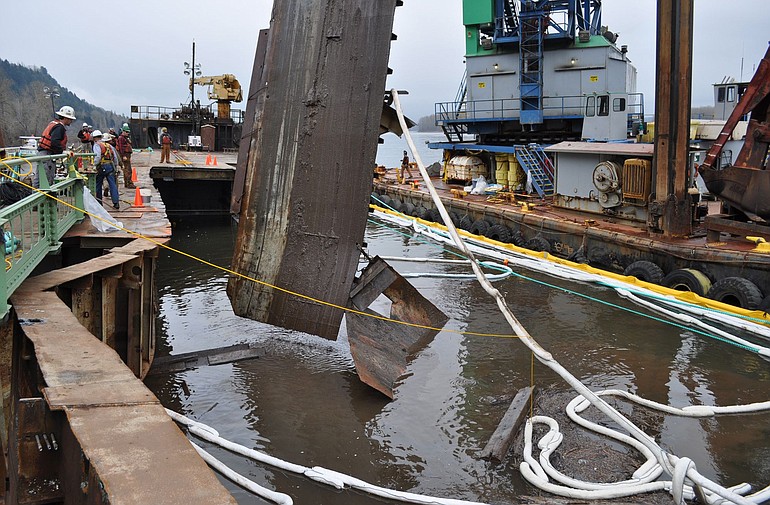Tar balls from the Davy Crockett have turned up in the Columbia River, four miles downstream from the beached and broken barge.
The small, dark, sticky globs were discovered below the Interstate 205 bridge on Tuesday and Wednesday.
“We’ve got people downstream monitoring for sheening,” said Ecology spokeswoman Kim Schmanke. “I believe these were found by Ecology, actually.”
Tests showed the tar balls do not contain polychlorinated biphenyls or heavy metals. Officials believe the tar balls were loosened and escaped into the river as workers removed heavy bunker fuel from the 431-foot vessel sitting on the north bank of the river between Vancouver and Camas.
Tar balls from the Davy Crockett have turned up in the Columbia River, four miles downstream from the beached and broken barge.
The small, dark, sticky globs were discovered below the Interstate 205 bridge on Tuesday and Wednesday.
"We've got people downstream monitoring for sheening," said Ecology spokeswoman Kim Schmanke. "I believe these were found by Ecology, actually."
Tests showed the tar balls do not contain polychlorinated biphenyls or heavy metals. Officials believe the tar balls were loosened and escaped into the river as workers removed heavy bunker fuel from the 431-foot vessel sitting on the north bank of the river between Vancouver and Camas.
Anyone who discovers what they believe to be tar balls should contact the National Response Center hot line at 800-424-8802. The 25 tar balls discovered this week ranged in size from a half-inch to 3 inches in diameter. They do not appear to produce a sheen when disturbed.
Anyone who discovers what they believe to be tar balls should contact the National Response Center hot line at 800-424-8802. The 25 tar balls discovered this week ranged in size from a half-inch to 3 inches in diameter. They do not appear to produce a sheen when disturbed.
The Davy Crockett, beached and broken on the north bank of the Columbia River near Vancouver since January, will be taken away in two pieces, salvage officials said Thursday.
Contractors plan to saw the 431-foot barge in half, refloat both halves, then tow the two ends of the World War II-era freighter to an unspecified dry dock for proper scrapping.
The stern section could be floated away by the end of this month, said Mike Greenburg, on-scene coordinator for the Oregon Department of Environmental Quality.
Authorities are making allowances if the tow goes awry.
“We’re going to be scouting ahead for grounding areas,” Greenburg said.
Contractors are consulting with naval architects to ascertain the risk of the vessel sinking in transit, a worst-case scenario that would create a lingering hazard in the Columbia River’s shipping channel.
The audacious removal plan was disclosed during a conference call Thursday involving incident commanders with the DEQ, the Coast Guard and the Washington state Department of Ecology. The recovery operation has already triggered an estimated $5.3 million in costs, and the Coast Guard currently has the ability to tap an additional $2.2 million from the federal Oil Spill Liability Trust Fund.
“The $7.5 million should take us through the separation cut and the tow of the stern,” U.S. Coast Guard Capt. Daniel LeBlanc said.
He said the ultimate cost of the cleanup is uncertain. Commanders have not settled on a contract with a facility capable of scrapping the vessel in dry dock, nor have they determined the precise plan for towing and dismantling both ends of the vessel.
Costs could go up substantially if the Coast Guard determines it’s not possible to tow the Crockett away. In that case, contractors would have to assemble a temporary cofferdam around the vessel and dismantle it in place.
“That is a much more intensive process than we’re hoping to achieve here,” Greenburg said.
“It would be a very distant option,” LeBlanc added.
Officials have attributed the sorry state of the Davy Crockett to owner Brett Simpson of Ellensburg. They said an effort to scrap the vessel while it was afloat weakened the Crockett to the point that its midsection buckled and sank. Adm. Robert Papp, the Coast Guard’s commandant in Washington, D.C., agreed last month to dismantle and remove the vessel from state-owned aquatic land.
The stern, which is in better shape, will depart first.
“We hope to do something similar with the bow end, but we’re not as far along on the details of that,” Greenburg said.
The more-degraded bow section won’t make it off the shoreline until later, after contractors evaluate whether it can be removed in one piece or will have to be cut into several sections. In any case, officials expect the Davy Crockett to be completely removed from the Columbia River shoreline by June.
LeBlanc defended the cost of the operation so far.
“There has been some meticulous work going on,” LeBlanc said. “A host of folks are doing some extensive sampling, waste disposal and making sure we’re doing everything safely to protect the environment as we move as aggressively as we can separating the vessel and moving toward land-side destruction.”
As of Thursday, contractors had removed 650,103 pounds of assorted debris and 73,257 gallons of an oil-water mixture.
The cost of the cleanup is being underwritten by the Oil Spill Liability Trust Fund, a federal fund created by a tax on petroleum products.
The vessel’s owner, Simpson, has not been involved in the operation since Jan. 27, LeBlanc said.
The Coast Guard federalized the response that day, after state Department of Ecology spill-response specialists traced a 15-mile-long sheen of oil to the Crockett, just three days after the Coast Guard assumed that Simpson had complied with an order to remove the hazard.
The Coast Guard is conducting a separate investigation of the actions that led to the debacle.
Erik Robinson: 360-735-4551, or erik.robinson@columbian.com.



